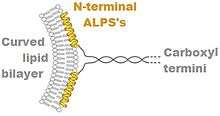Amphipathic lipid packing sensor motifs
Amphipathic Lipid Packing Sensor (ALPS) motifs were first identified in 2007 in ARFGAP1[1] and have been reviewed.[2][3]
The curving of a phospholipid bilayer, for example into a liposome, causes disturbances to the packing of the lipids on the side of the bilayer that has the larger surface area (the outside of a liposome for example). The less "ordered" or "looser" packing of the lipids is recognized by ALPS motifs.
ALPS motifs are 20 to 40 amino acid long portions of proteins that have important collections of types of amino acid residues. Bulky hydrophobic amino acid residues, such as Phenylalanine, Leucine, and Tryptophan are present every 3 or 4 positions, with many polar amino acid residues such as Glycine, Serine and Threonine between. The ALPS forms an alpha helix when associated with the bilayer, such that the hydrophobic residues associate with the lipids and the polar residues associate with the aqueous cytoplasm.
References
- ↑ Drin G, Casella JF, Gautier R, Boehmer T, Schwartz TU, Antonny B (2007). "A general amphipathic alpha-helical motif for sensing membrane curvature". Nature Structural & Molecular Biology. 14 (2): 138–46. doi:10.1038/nsmb1194. PMID 17220896.
- ↑ Bradshaw, Ralph A.; Stahl, Philip D. (2015). Encyclopedia of Cell Biology (1st ed.). Cambridge MA: Academic Press. p. 206. ISBN 0123944473.
- ↑ Vanni S, Vamparys L, Gautier R, Drin G, Etchebest C, Fuchs PF, Antonny B (2013). "Amphipathic lipid packing sensor motifs: probing bilayer defects with hydrophobic residues". Biophysical Journal. 104 (3): 575–84. doi:10.1016/j.bpj.2012.11.3837. PMC 3566459. PMID 23442908.
- ↑ Horchani H, de Saint-Jean M, Barelli H, Antonny B (2014). "Interaction of the Spo20 membrane-sensor motif with phosphatidic acid and other anionic lipids, and influence of the membrane environment". PLoS One. 9 (11): e113484. doi:10.1371/journal.pone.0113484. PMC 4245137. PMID 25426975.
